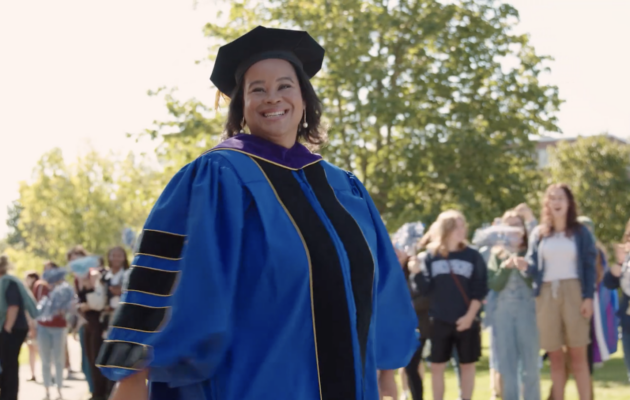Having collaborated closely with higher education communications and marketing departments, the Boston video production team at Shave understands the integral role these offices play in shaping presidential communications for both the campus community and wider audiences.
Video is an invaluable tool for this purpose, personalizing the president’s message while making it more accessible and engaging to viewers. Statistically, people are more inclined to engage with video content compared to reading traditional email communications, highlighting the value of this format.
This type of video can take many forms, depending on the goal of the communication and how the video will be viewed. When considering each approach, here are some elements to keep in mind:
Straight-to-camera delivery
- This works well for short, scripted communications about campus initiatives and updates, greetings, or more serious topics.
- One or two cameras? One is usually fine, but the use of two cameras greatly helps in post-production, enabling the editor to cut between angles.
- Teleprompters are invaluable when doing a scripted shoot. The speaker is able to look straight into the lens without seeming like they’re reading, which makes it feel more personal.
- Virtual messages (recorded remotely or on a smartphone) also work under certain circumstances, if lower video quality is not a concern.
Campus b-roll accompanied by a voiceover
- This approach allows for a variety of visuals that can help emphasize the tone and goals of the messaging.
- The audio could be entirely voiceover (where you never see the person’s face), or a mix of b-roll and interview footage.
- An advantage of using pure voiceover is that you can record it separately as audio only, cutting down the production time significantly.
- B-roll can be captured specifically for the project, or pulled from an existing footage library.
Q&A sessions
- Producing a question and answer video with a president is a great way to make them seem more approachable, especially when students are asking the questions, and the questions are light and personal (i.e. “what’s your favorite movie?”).
- Q&A sessions work well for social media, since they are more informal and can be cut up in a number of different ways.
- Work closely with the client to select an interviewer and to generate questions that make sense within the context of the video, and in the places it will be pushed out.
- Having at least two cameras (one on the interviewer and one on the interviewee) is enormously helpful in production, and will save time in the edit.
Panels or interview series
- Another way to generate a conversation and make the president seem accessible is to have them conduct informative interviews or panels with interviewees such as students, alumni, or staff.
- These videos tend to be longer, and could be pushed out as a series on the school’s website or edited for use on social media platforms.
- Two or three cameras are best for this type of production, allowing for more flexibility in production and the edit.
Creative, outside-the-box
- A creative video might employ imaginative elements like stop motion animation, montages based on a word or concept, archival photos, or anything we brainstorm with the client’s creative team.
- You always have the option to include a brief message from the president (voiceover or straight-to-camera) at the beginning or end of the video, or just text on a closing slide.
- This type of video works well to accompany a lighter communication from the president, such as a greeting. It could also live on as a standalone piece with some slight editing tweaks, gaining social media traction.
Ultimately, a successful presidential communications video not only presents the president in a favorable light, but also achieves clarity; it delivers a message in an effective and appealing manner, leaving viewers feeling confident in their president and the institution’s objectives.
Click here to explore more of our higher education video work.
